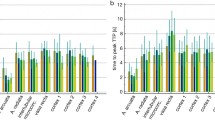Abstract
The aim of this study was to assess the feasibility of contrast-enhanced ultrasound (US) at low transmission power insonation for diagnosis of focal renal perfusion defects (RPDs) in rabbits. In seven adult New Zealand White rabbits focal RPDs were induced by polyvinyl alcohol embolizing particles (150–250 μm in diameter) injected into the abdominal aorta. Three other rabbits that were not subjected to embolization were considered as controls. Both kidneys were insonated at baseline and after injection of sulphur hexafluoride-filled microbubbles at low transmission power (mechanical index 0.09–0.12). One sonologist assessed on-site RPD dimensions and conspicuity (visual score 0–4). Digital cine-clips were also reviewed off-site by two other independent readers, blinded, who assigned a confidence level (grades 1–5) for the RPD diagnosis. At on-site analysis RPDs appeared as focal areas of absent or diminished enhancement with a median visual conspicuity score=4. At off-site analysis RPDs >6 mm in diameter were identified at contrast-enhanced US, and the confidence in RPD diagnosis improved significantly (P<0.05) after microbubble injection (area under receiver operating characteristic curve 0.615 vs 0.972 by reader 1; 0.720 vs 0.953 by reader 2). Contrast-enhanced US at low transmission power insonation effectively identified RPDs with diameters >6 mm in rabbits.





Similar content being viewed by others
References
Racusen LC, Solez K (1994) Renal infarction, cortical necrosis, and atheroembolic disease. In: Tisher CC, BM Brenner (eds) Renal pathology with clinical and functional correlations, 2nd edn. Lippincott, Philadelphia, pp 810–831
Teplick JG, Yarrow MW (1955) Arterial infarction of the kidney. Ann Intern Med 42:1041–1051
Kawashima A, Sandler CM, Ernst RD et al (2000) CT evaluation of renovascular disease. Radiographics 20:1321–1340
Wong WS, Moss AA, Federle MP (1984) Renal infarction: CT diagnosis and correlation between CT findings and etiologies. Radiology 150:201–205
Quaia E, Bertolotto M (2002) Renal parenchymal diseases: is characterization feasible with ultrasound? Eur Radiol 12:2006–2020
Coley BD, Mattrey RF, Roberts A, Keane S (1991) Potential role of PFOB enhanced sonography of the kidney. II. Detection of partial infarction. Kidney Int 39:740–745
Taylor GA, Ecklund K, Dunning PS (1996) Renal cortical perfusion in rabbits: visualization with color amplitude imaging and an experimental microbubble-based US contrast agent. Radiology 201:125–129
Taylor GA, Barnewolt CE, Adler BH, Dunning PS (1998) Renal cortical ischemia in rabbits revealed by contrast-enhanced power Doppler sonography. Am J Roentgen 170:417–422
Whittingham T (2005) Contrast-specific imaging techniques: technical perspective. In: Quaia E (ed) Contrast media in ultrasonography: basic principles and clinical applications. Springer, Berlin Heidelberg New York, pp 43–70
Munzing D, Mattrey RF, Reznik VM et al (1990) The potential role of PFOB enhanced sonography of the kidney: part I—detection of renal function and acute tubular necrosis. Kidney Int 39:733–739
Taylor GA, Barnewolt CE, Claudon M, Dunning P (1999) Depiction of renal perfusion defects with contrast-enhanced harmonic sonography in a porcine model. Am J Roentgen 173:757–760
Girard MS, Mattrey RF, Baker KG et al (2000) Comparison of standard and second harmonic B-mode sonography in the detection of renal infarction with ultrasound contrast in a rabbit model. J Ultrasound Med 19:185–192
Mattrey RF, Steinbach G, Lee Y et al (1998) High-resolution harmonic gray-scale imaging of normal and abnormal vessels and tissues in animals. Acad Radiol 5 [Suppl]:S63–S65
Quaia E (2005) Classification and safety of microbubble-based contrast agents. In: Quaia E (ed) Contrast media in ultrasonography: basic principles and clinical applications. Springer, Berlin Heidelberg New York, pp 43–70
Beck JR, Shultz EK (1986) The use of relative operating characteristic (ROC) curves in test performance evaluation. Arch Pathol Lab Med 110:13–20
Hanley JA, McNeil BJ (1983) A method of comparing the areas under receiver operating characteristic curves derived from the same cases. Radiology 148:839–843
Jakobsen JA, Oyen R, Thomsen HS, Morcos SK, Members of the Contrast Media Safety Committee of the European Society of Urogenital Radiology (2005) Safety of ultrasound contrast agents. Eur Radiol 15:941–945
Claudon M, Barnewolt C, Taylor GA et al (1999) Renal blood flow in pigs: changes depicted with contrast-enhanced harmonic US imaging during acute urinary obstruction. Radiology 212:725–731
Kim B, Lim HK, Choi MH et al (2001) Detection of parenchymal abnormalities in acute pyelonephritis by pulse inversion harmonic imaging with or without microbubble ultrasonographic contrast agent. J Ultrasound Med 20:5–14
Schmiedl UP, Carter S, Martin RW et al (1999) Sonographic detection of acute parenchymal injury in an experimental porcine model of renal hemorrhage: gray-scale imaging using sonographic contrast agent. Am J Roentgenol 173:1289–1294
Correas JM, Helenon O, Moreau JF (1999) Contrast enhanced ultrasonography of native and transplant kidney diseases. Eur Radiol 9 [Suppl 3]:394–400
Correas JM, Claudon M, Tranquart F, Hélenon O (2003) Contrast-enhanced ultrasonography: renal applications. J Radiol 84:2041–2054
Schneider M, Arditi M, Barrau MB et al (1995) BR1: a new ultrasonographic contrast agent based on sulphur hexafluoride-filled microbubbles. Invest Radiol 30:451–457
Morel DR, Schwieger I, Hohn L et al (2000) Human pharmacokinetics and safety evaluation of SonoVue, a new contrast agent for ultrasound imaging. Invest Radiol 35:80–85
Nilsson A (2004) Contrast-enhanced ultrasound of the kidneys. Eur Radiol 14 [Suppl 8]:P104–P108
Richard B (1999) Test object for measurement of section thickness at US. Radiology 211:279–282
Skolnick ML (1991) Estimation of ultrasound beam width in the elevation (section-thickness) plane. Radiology 180:286–288
Acknowledgements
This work was supported by Philips Research grant from the ECR Research and Education Fund 2004.
Author information
Authors and Affiliations
Corresponding author
Rights and permissions
About this article
Cite this article
Quaia, E., Siracusano, S., Palumbo, A. et al. Detection of focal renal perfusion defects in rabbits after sulphur hexafluoride-filled microbubble injection at low transmission power ultrasound insonation. Eur Radiol 16, 166–172 (2006). https://doi.org/10.1007/s00330-005-2866-y
Received:
Revised:
Accepted:
Published:
Issue Date:
DOI: https://doi.org/10.1007/s00330-005-2866-y




